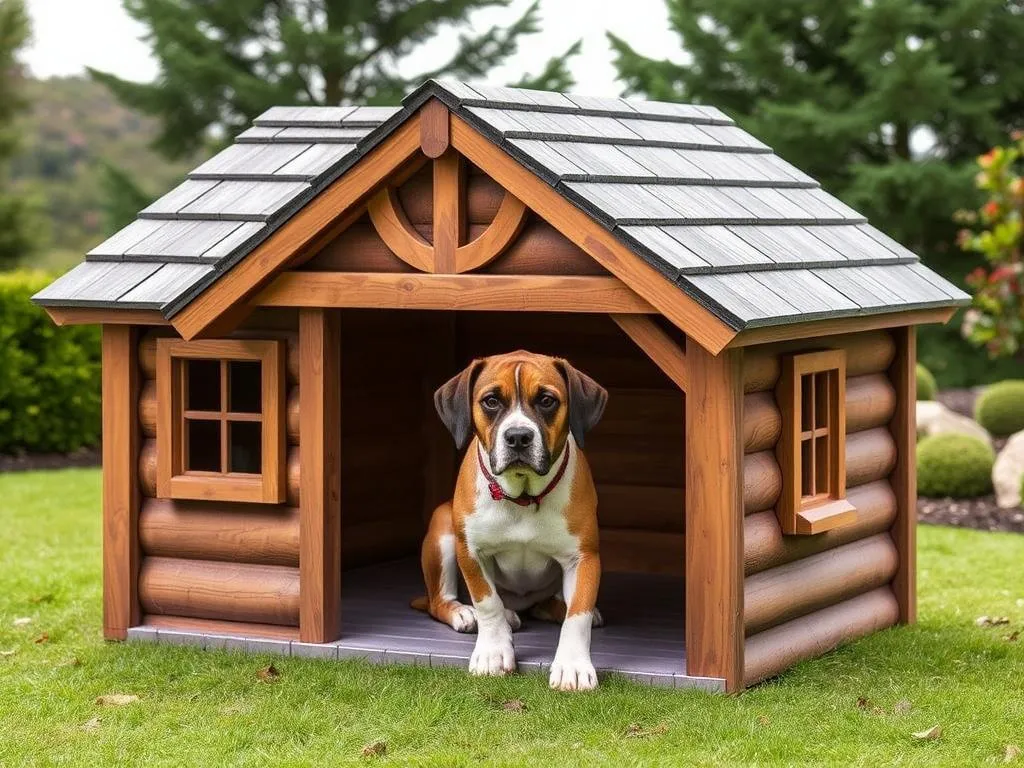
Providing a suitable dog house for large dogs is crucial for their well-being and happiness. A dog house offers them a sense of security and comfort, serving as a personal space where they can retreat and relax. It’s essential to choose a dog house that meets their specific needs, ensuring they are protected from the elements and have room to move comfortably. Below, we’ll delve into various aspects of selecting the best dog houses for large dogs, helping you make the right choice for your furry friend.
Understanding the Needs of Large Dogs
Size Considerations
When selecting a dog house for large breeds, size is paramount. A dog house that is too small can lead to discomfort and stress for your pet. Ideally, the dog house should be spacious enough for your dog to stand up, turn around, and lie down comfortably.
For instance, a Golden Retriever may require a dog house that measures at least 30 inches in height, 36 inches in width, and 30 inches in depth. On the other hand, a German Shepherd could benefit from dimensions closer to 32 inches in height, 40 inches in width, and 36 inches in depth. Always consider your dog’s breed and size when making this decision.
Weather Protection
Large dogs are particularly susceptible to the effects of harsh weather. A well-insulated dog house can keep them warm during winter and cool during summer. It’s crucial to choose a dog house that provides adequate insulation to maintain a comfortable temperature. Additionally, proper ventilation helps prevent overheating in the summer months while keeping the interior dry in the winter.
Safety and Comfort
Safety features should be a top priority when selecting a dog house. Look for designs that avoid sharp edges and include sturdy construction to withstand the wear and tear of outdoor conditions. Comfort is equally important; a dog house should have appropriate flooring that is not too cold or damp. Providing enough space for them to stretch out comfortably will help ensure they feel secure and content.
Types of Dog Houses for Large Dogs
Wooden Dog Houses
Advantages: Wooden dog houses are durable and offer excellent insulation, keeping your dog warm in colder weather. They also have a classic aesthetic appeal that many pet owners prefer.
Disadvantages: On the downside, wooden houses can require regular maintenance, such as sealing and painting, to protect against the elements. They are also heavier than other materials, making them less portable.
Plastic Dog Houses
Advantages: Plastic dog houses are lightweight and easy to clean, making them a favorite among pet owners who prioritize hygiene. They typically come with built-in drainage holes and are resistant to rot and pests.
Disadvantages: However, they often lack the insulation properties of wood, which can be a concern in extreme weather conditions. Additionally, their appearance may not blend well with natural surroundings.
Elevated Dog Houses
Elevated dog houses are designed off the ground, which can be beneficial in multiple ways.
Benefits of elevation: They provide protection from moisture and pests, keeping your dog dry and safe. Elevated houses are ideal in hot climates where airflow can help keep the dog cool.
Outdoor Kennels
Outdoor kennels are another option for large dogs, providing a secure and spacious environment for them.
Pros: They offer ample space for your dog to move around and can be paired with a dog house for added comfort.
Cons: However, outdoor kennels can be more expensive and may require more significant space in your yard compared to traditional dog houses.
Key Features to Look for in a Dog House
Size and Dimensions
Proper sizing is essential for comfort and space. Measure your dog from the tip of their nose to the base of their tail and add a few inches for extra room. This measurement will guide you in selecting the right dimensions for the dog house.
Material Quality
The material used in the construction of the dog house can significantly impact its durability and weather resistance.
- Wood: Offers great insulation but requires maintenance.
- Plastic: Lightweight and easy to clean but may not provide enough insulation.
- Metal: Extremely durable but can become uncomfortably hot in the sun.
Insulation and Ventilation
Insulation is crucial for cold climates. Look for dog houses with insulated walls or those that can accommodate insulation material. In contrast, ventilation is necessary in warmer weather to keep the interior cool. Features like adjustable vents or raised roofs can help facilitate airflow.
Ease of Cleaning
A clean dog house is essential for your pet’s health. Features that make cleaning easier include removable roofs, detachable floors, and smooth surfaces that prevent the buildup of dirt and odors.
Top 5 Best Dog Houses for Large Dogs
Here are five of the best dog houses for large dogs, considering their features, pros and cons, and price points.
Product 1: Petmate Indigo Dog House
- Description and Features: The Petmate Indigo Dog House features a unique design with a roof that helps shed rain and snow, and it comes with an offset door for added protection against the elements.
- Pros: Durable, good insulation, and easy to clean.
- Cons: Some dogs may need time to get used to the enclosed space.
- Price Range: $150 – $250
Product 2: Suncast Outdoor Dog House
- Description and Features: The Suncast Outdoor Dog House is made from durable resin and has a raised floor to keep pets dry. It also features ventilation openings for airflow.
- Pros: Lightweight, easy to assemble, and good ventilation.
- Cons: Limited insulation for very cold climates.
- Price Range: $100 – $200
Product 3: Lucky Dog Uptown Welded Wire Kennel
- Description and Features: This outdoor kennel is made from heavy-duty wire and features a waterproof cover. It provides ample space for your dog to roam while still offering a cozy retreat.
- Pros: Spacious, secure, and great for multi-dog families.
- Cons: Requires a larger space in your yard.
- Price Range: $250 – $400
Product 4: Tuff-N-Rugged Dog House
- Description and Features: Made from sturdy plastic, the Tuff-N-Rugged Dog House features a slanted roof for water runoff and is designed for easy cleaning.
- Pros: Highly durable, easy to clean, and good weather resistance.
- Cons: Some dogs may find it less cozy compared to wooden houses.
- Price Range: $150 – $300
Product 5: Precision Pet Extreme Outback Dog House
- Description and Features: This wooden dog house is made from solid wood and features a raised floor, slanted roof, and adjustable ventilation.
- Pros: Good insulation, classic look, and easy to assemble.
- Cons: Requires maintenance to prevent wear.
- Price Range: $200 – $350
Tips for Setting Up the Dog House
Choosing the Right Location
When setting up your dog house, consider factors such as shade, wind protection, and accessibility. A location that offers natural shade can help keep your dog cool during the summer months, while positioning it away from strong winds can ensure they remain comfortable during colder weather.
Adding Bedding and Comfort Items
To enhance your dog’s comfort, add soft bedding materials such as blankets or dog beds. Consider using materials that are easy to wash and can withstand outdoor conditions. Additionally, comfort items like toys can help keep your dog entertained inside the house.
Regular Maintenance
Regular maintenance is crucial for keeping the dog house clean and safe. Check for any wear and tear, and clean the interior and exterior regularly to prevent the buildup of dirt, pests, and odors. Seasonal maintenance checks can also ensure the dog house remains functional year-round.
Frequently Asked Questions (FAQs)
How do I know what size dog house my dog needs?
To determine the right size for your dog house, measure your dog’s height and length. The house should be tall enough for your dog to stand comfortably and long enough for them to stretch out fully.
Can I build my own dog house for my large dog?
Yes, building your own dog house can be a rewarding project. Ensure you follow suitable designs that meet your dog’s size and needs, and use weather-resistant materials.
What are the best materials for a dog house?
The best materials for a dog house depend on your climate and personal preference. Wood offers great insulation, while plastic is lightweight and easy to clean.
How do I insulate a dog house for winter?
To insulate a dog house for winter, consider adding insulation materials to the walls and roof. Use straw or blankets for bedding to provide warmth and comfort.
How can I make my dog house more comfortable?
Enhancing comfort can be achieved by adding soft bedding, toys, and ensuring proper ventilation. A clean and safe environment will also contribute to your dog’s overall comfort.
Conclusion
Choosing the right dog house for large dogs is crucial for their comfort, safety, and well-being. By understanding your dog’s specific needs, considering the various types of dog houses available, and looking for essential features, you can make an informed decision. Prioritizing your dog’s comfort will not only keep them happy but also provide peace of mind knowing they have a secure place to call their own.









